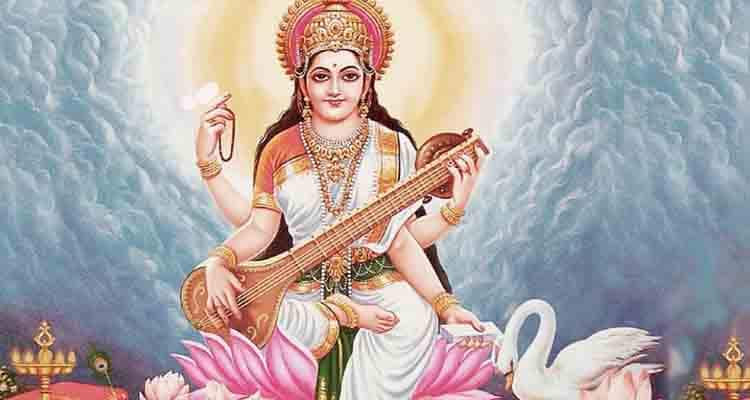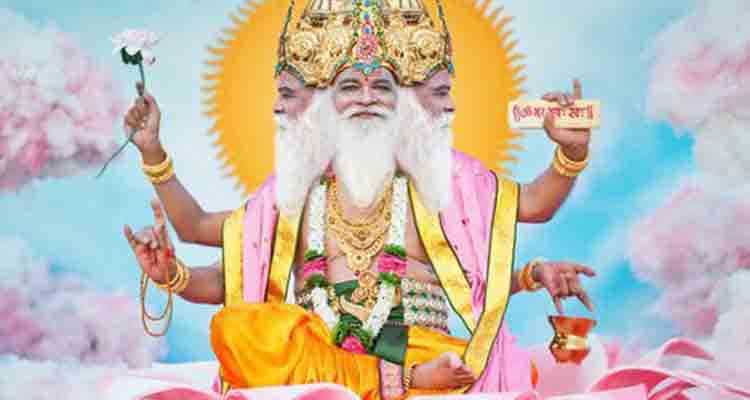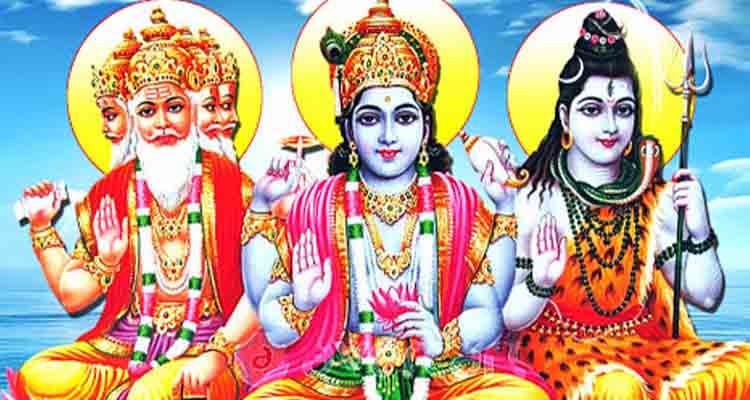Unlike the other goddesses eager for matrimony and motherhood, Saraswati is singularly aloof. Her white complexion and attire ̶ almost window-like ̶ indicate her asceticism, transcendence and purity. There is, however, one oddity in her otherwise stated story – her purported relationship with Brahma.
The Vedic Saraswati – Who Was She?
The Vedic Saraswati was essentially a fluid, riverine goddess, who was thought to grant bounty, fertility, and purity to those who prayed by her mighty banks. One of the first rivers to be attributed divinity, she was to the Vedic people what the Ganga is to Hindus today. A little later, she came to be identified with Vag (Vac) Devi – the goddess of speech. There isn’t a Hindu student who has not worshipped Saraswati, the goddess of learning, before the exams. In fact, Saraswati is omnipresent in so many countries apart from India. She is worshipped and venerated in countries like China, Japan, Burma, and Thailand. She is a part of the trinity of Saraswati, Lakshmi, and Parvati who help in the creation and maintenance of the universe by being with Brahma, Vishnu, and Shiva. Followers of the Jain religion also worship Saraswati. She was yet an abstraction, like most Vedic deities. A more solid personification of her character came about in the Mahabharata, where she was said to be Brahma’s daughter. The Puranas (the Matsya Purana, for example) then tell us how she became his wife. And this is where the story of our interest starts…the story of Brahma and Saraswati.
Brahma, the Creator of Saraswati
At the beginning of a kalpa, a divine lotus sprung from Vishnu’s navel, and from it emerged the grandfather of all creation, Brahma. From his mind and his various forms, he produced gods, seers, demons, men, creatures, days and nights, and many such creations. Then at one point, he split his body in two – one of which became the goddess Shatarupa, she of a hundred forms. She was verily named Saraswati, Savitri, Gayatri, and Brahmani. This is how the Brahma Saraswati story started and the Brahma – Saraswati relationship is that of father and daughter. But there was no stopping Brahma and he exclaimed over and over again how beautiful she was. Brahma became completely infatuated with her unable to stop his eyes from following her, he sprouted four heads (and eyes) in four directions, and then a fifth on top, when Saraswati sprang upward to evade his attention. He also tried to show his lordship on her, while she tried to escape from his stares and gaze.
Rudra severed the fifth head of Brahma
A popular version of this story makes an interjection at this point and introduces Rudra-Shiva. We are told that the ascetic god was so disgusted by Brahma’s behaviour, that he lopped off the later’s fifth head. This served as a punishment to Brahma for showing attachment to his creation. This is why we see Brahma with his four heads only. In another version, Brahma’s punishment came by way of him losing all his powers of tapas, due to his desire for his daughter. Now powerless to create, he had to appoint his sons to take forth the act of creation. Brahma was now free to ‘own’ Saraswati. He made love to her, and from their union, the progenitors of mankind were born. Brahma and Saraswati became the Cosmic Couple. They lived together for 100 years in a secluded cave and apparently Manu was their son.
The story of Brahma and Saraswati
In another version of the Brahma Saraswati story, however, we are told that Saraswati was not as complicit as Brahma had hoped. She ran from him and assumed the female forms of many a creature, but Brahma was not to be spurned and followed her across the universe with the corresponding male forms of those creatures. They were eventually ‘married’ and their union gave rise to all manner of species. From a sociological perspective, the idea of incest is one of the most universal taboos, and yet it exists as a foundational myth in most cultures. It has to do with the problem of the first man and first woman in any creation story. Being born from the same source, the first couple is naturally also siblings, and having no other choice, must also pick each other as sexual partners. While such acts are shunned in human societies, gods get divine sanction. But is that really so? The Brahma and Saraswati relationship did not receive the sanctity that is expected of all divine relationships and Brahma’s incestuous pursuit did not fetch him a good place in mythology.
The reason why there are no temples of Brahma
You must have noticed that Brahma temples are not common, unlike Shiva and Vishnu temples that can be found across the country’s length and breadth. Because Brahma lusted after his own creation, Indians have not been that forgiving and have ceased to worship him. Apparently Brahma worship was stopped here because he did such a ‘terrible thing’, and that’s why there are no Brahma temples in India (which is not true really, but that’s a story for another day). Another legend has it that Brahma is the creator; the exhausted energy, while Vishnu is the maintainer or the present, and Shiva is destructor or the future. Both Vishnu and Shiva are the present and future, which is valued by people. But past is left out- and that is why Brahma is not worshipped. ‘Love is love; doesn’t hold true after all, for myths make social codes. Brahma’s love for Saraswati is deemed wrong as a father’s sexual love for his daughter and as a creator’s egoistic love for his creation. This queasy story serves as a reminder that certain kinds of ‘love’ exist in men, no matter how wrong these might seem. But most importantly, it issues a stern warning that there is always a price to pay – either the loss of pride (head), power (of creation), or complete social ostracism. Some relationships are hard to accept, especially if they affect you personally. Soul Searcher shared his story of the relationship between his wife and his father.




